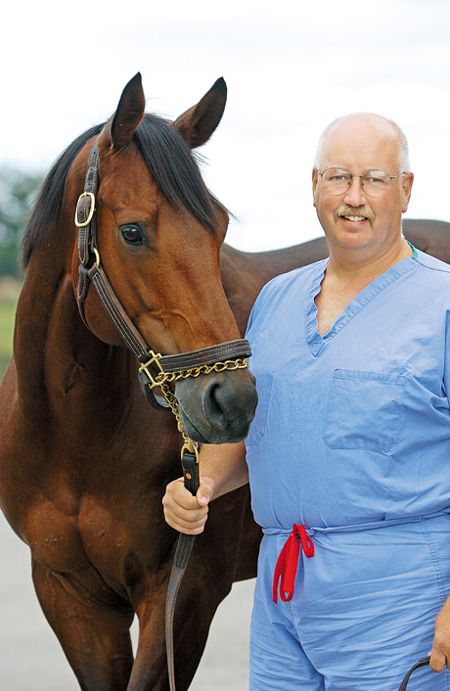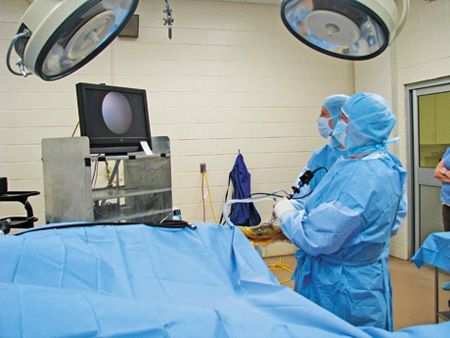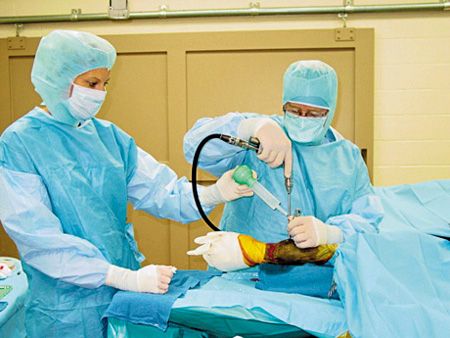Dr. Larry Bramlage: A career dedicated to healing horses
This renowned veterinary orthopedic surgeon says his success has been due to a lot of luck and stumbling into the right mentors along the way.

Dr. Larry Bramlage has dedicated his life to ensuring the health and well-being of horses. (Photo courtesy of the AAEP.)
Growing up in Frankfort, Kansas, Larry Bramlage, DVM, MS, DACVS, thought he was destined to become a bovine veterinarian. His father worked for a cattle company and ran a sale barn. “That was the only veterinary medicine that I knew,” says Bramlage, now an orthopedic surgeon and a partner at Rood & Riddle Equine Hospital in Lexington, Kentucky.
His father's veterinarian was Bramlage's first professional influence. What's more, this doctor's son was Bramlage's high school classmate and played beside him in basketball, baseball and football. At the end of Bramlage's junior year in high school, the guidance counselor called him in to ask him what his plans were for after graduation. Bramlage didn't have any. The counselor told him to think about it over the weekend and come in to discuss it the following week.
It just so happened that Bramlage was helping his dad work cattle over that weekend. The veterinarian, Dr. Keith Beeman, came out to do some work and Bramlage assisted him as he always did. He reported back to his guidance counselor that next Monday and stated, “I want to be a veterinarian.” The counselor, an influential and diligent mentor, replied, “The school you'll go to is Kansas State University (KSU)-you'll have preferential admission.” He advised Bramlage on how to apply and receive financial aid. After taking the advice, Bramlage went off to veterinary school.
A distinguished career
Bramlage is a diplomate of the American College of Veterinary Surgeons and a past regent and president of American College of Veterinary Surgeons as well as a past member of the board of directors and president of the AAEP. Bramlage is also a member of the American Veterinary Medical Association, Kansas Veterinary Medical Association and Kentucky Veterinary Medicine Association.
Through the years, Bramlage's orthopedic expertise has provided much to equine practice, and many fortunate horses have benefited from his skilled, gentle hands, which has not gone unnoticed:
> He was recipient of a Gold Medal for Contributions to Thoroughbred Racing from the Jockey Club of America in 1994.
> He won a Special Award of Merit from the British Equine Veterinary Association in 2000.
> In 2001, Dr. Bramlage was recognized by Kansas State University as an Alumni Fellow for the College of Veterinary Medicine.
> He earned a distinguished service award from the AAEP in 2005.
> He received the Joe Palmer Award from the Turf Writers of America for service to Thoroughbred racing in 2007.
> In 2010, the American College of Veterinary Surgeons presented him with its Legends Award for contributions to equine orthopedic surgery.
> In September 2014, he was one of three veterinarians honored by the Thoroughbred Club of America at its 83rd testimonial dinner.
> In 2014, he received the Alumni Recognition Award from Kansas State University as well as a second Distinguished Service Award from the AAEP.
From bovine to equine
While at KSU, Bramlage met another key mentor, Dr. Gene Schneider. “He took an interest in me and was the first person who took me to the racetrack-to Fonner Park in Grand Island, Nebraska,” Bramlage recalls. But instead of going to the races, they spent the morning watching horses training.
“I went there in awe of the thoroughbreds, though I'd been around cattle horses all my life,” Bramlage says. “Watching the thoroughbreds train, I thought I'd never seen anything like it. I fell in love to what they were doing and how they were doing it.”
After Bramlage earned his DVM from KSU in 1975, he did an internship at Colorado State University (spending six months with Dr. O.R. Adams, author of the first Lameness in Horses text) and then ended up in a residency at The Ohio State University (OSU) College of Veterinary Medicine with Dr. Al Gabel. “Dr. Gabel was probably as influential about life as he was about veterinary medicine,” Bramlage says. “He gave his residents lots of encouragement and guidance.”
Bramlage stayed on at the OSU College of Veterinary Medicine as a young faculty member. While at OSU, he developed a strong interest in plating bones-a new technique at the time. Some work had been done by Dr. Jacques Jenny at the University of Pennsylvania (who had established the specialty of orthopedic surgery in the horse) and Dr. Bruce Hohn, an orthopedic surgeon at OSU who in 1976 performed the first total hip replacement in a dog. Dr. Hohn taught Bramlage about the new bone plating technology, a procedure commonly done by the Swiss at the time. “That became my hobby,” Bramlage says.

Bramlage performs surgery on a horse at Rood & Riddle Equine Hospital, where he is a partner. (Photo courtesy of Rood & Riddle.)
Groundbreaking procedures
Eventually Bramlage developed a surgical procedure called fetlock arthrodesis, used to treat a catastrophic fetlock injury that used to cause death in most affected horses due to contralateral laminitis. “But once we could fuse the fetlocks painlessly, we saved the majority of those horses, as we do now,” Bramlage says.
The fetlock arthrodesis procedure has remained the gold standard for that type of fetlock injury. “That indirectly led me to my friendship with Dr. Robert Copelan, as he too was interested in the procedure, eventually referring me to several horses,” Bramlage recounts. “He is and remains a good friend and a strong mentor for me. I learned a lot from him, about the racing business, and about integrity, how you deal with people.”
Bramlage says that people in his era were fortunate, coming along in a golden era of veterinary medicine. For one thing, practical general anesthesia had just come of age. “Before the time I was doing the residency, it was not very easy to anesthetize a horse for a couple of hours and have it recover,” he says. “But about that time the anesthesiologists became very competent in doing it in horses, and that opened up lots of avenues for me.”
In 1982 Bramlage was doing some work for a woman whose husband, Frank Noyes, was a human physician conducting research at the Air Force base in Dayton, Ohio. Bramlage got to know Noyes through his wife, who owned hunters with lameness problems. Bramlage and Noyes began discussing various injuries and treatments, and as Noyes was hosting one of the first human arthoscopy courses in Cincinnati, he invited Bramlage to attend. “That's how I got started in arthroscopy,” Bramlage says. “We came along just as the technology made it practical to operate on horses' joints with arthroscopy, or to plate horses' bones. We had a lot of opportunities just by coincidence.”
In 1983, Bramlage moved from Ohio to New Jersey to open a private practice for a year (Sterlingbrook Equine Center in Pittstown), came back to OSU and began consulting in Lexington, Kentucky. Bramlage eventually moved to Lexington, which allowed him to spend more time with his children, coach their baseball teams and eventually practice at Rood & Riddle.
“From there on I've narrowed my career more and more,” Bramlage says. “When I began, veterinarians did all kinds of surgery-abdominal surgery, urogenital surgery, throat surgery-we did everything. But Dr. Gabel at Ohio State was one of the first people in the country who said, ‘You guys need to separate and get really good at one aspect of what you do.' So we split the surgeons at Ohio State into general surgery and orthopedic surgery.”
Bramlage's career has reflected his mentor's advice. He went from doing every kind of surgery to doing mostly orthopedic surgery to only doing orthopedic surgery in racehorses, including lameness exams, a portion of orthopedic surgery.

Bramlage has pioneered many new surgical techniques in the realm of equine orthopedics to get horses back in the race. (Photo courtesy of Rood & Riddle.)
A couple of fortuitous surgeries
“The first really good animal I fused was a horse named Noble Dancer,” Bramlage says. “He was probably the 10th horse I'd fused.” Dr. Bill Reed called Bramlage from New York to tell him that trainer Tommy Kelly had a nice horse that just ruptured his suspensory apparatus. Reed had attended a course where Bramlage described the fusing technique and said he wanted to try it on Noble Dancer. “We did the procedure on him, who at the time was just short of $1 million in earnings, a huge amount in 1978! We fused him, and he became a stallion,” says Bramlage.
Bramlage says his favorite case, and one that provided another landmark in his career, was Personal Ensign. He used internal fixation to fix a P1 fracture, putting five screws in the horse's right hind pastern. “She was important not only to me, but also to the profession,” says Bramlage. “She was really the first prominent horse that showed that not only could you save those horses for breeding if you did a good job with internal fixation but some of them then could come back and perform well.” Bramlage says that in most horses internal fixation surgery is now fairly routine.
“Personal Ensign was such a good horse-an amazing athlete,” says Bramlage. “She happened to be such a talented athlete that she made the internal fixation famous.”
AAEP On-Call Veterinarian
In 1990, Go For Wand had her major accident in the Breeders' Cup Distaff at Belmont Park and was fatally injured. A group of concerned racing industry leaders decided, “We have to do something different,” as the accident was being shown over and over again on TV. Gary Carpenter, executive director of AAEP at the time, developed the idea of having a media-trained AAEP member available to the networks, and, with the support of others in the industry, the On-Call program was started. “That was an epiphany of good thinking,” Bramlage says.
The AAEP hired two media trainers, Joan McGrath and Myrna Pederson, to coach a group of veterinarians for their new roles.
The first time at the Breeders' Cup, the AAEP sent seven veterinarians each to do a different race. Television executives “hated it,” Bramlage says, because there was no continuity and they didn't know the veterinarians. So the program was changed.
In 1991, Dr. Bramlage did his first solo AAEP On-Call assignment at the Breeders' Cup at Churchill Downs doing all seven races. That year, Filago broke down in the Breeders' Cup Turf turning for home. “They interviewed the jockey, who incorrectly noted the horse ‘had broken his leg clean off,' which didn't make for very good television,” Bramlage says. So Curt Gowdy Jr., the ABC producer, said, “Try the vet.”
“I did what I was taught-to describe the injury and bridge forward to describing what's happening next to care for the horse instead of dwelling on the injury,” Bramlage says. “One of the fortuitous things was that the injury was what I did-I plated bones, and it was easy for me to talk about that stuff. In fact, I subsequently did the fetlock arthrodesis on Filago and he became a stallion in Argentina.”
After this success, ABC asked him to be the On-Call Veterinarian for both the Breeders' Cup and the Kentucky Derby. Bramlage was perfect for the job-his gentle demeanor linked with his equine expertise made for an excellent rapport with the television-viewing public. In future years he was joined at the Breeders' Cup by Wayne McIlwraith, BSVc, DACVS, of Colorado State University College of Veterinary Medicine.
As of 2015, the AAEP is adding new veterinarians to the program, and Bramlage and McIlwraith are stepping down. They'll be sorely missed, and their tenure as AAEP On-Call veterinarians will be hard to follow-especially their careful assessment in cases such as Barbaro's breakdown in the 2006 Preakness and Eight Belles' injury in the 2008 Kentucky Derby.
Bramlage looks back on his career humbly. “It's really a combination of stumbling into exactly the right mentors and a lot of luck because a lot of technology made it possible for people of my generation to do what we do,” he says.
Ed Kane, PhD, is a researcher and consultant in animal nutrition, He is an author and editor on nutrition, physiology and veterinary medicine with a background in horses, pets and livestock. Kane is based in Seattle.